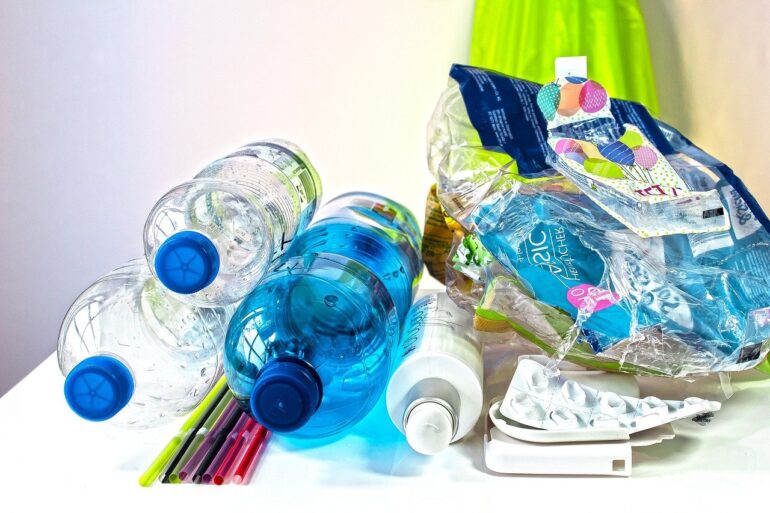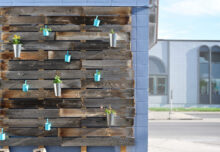
Although most consumers are not aware of this, waste management companies collect and sort plastic in one of seven different ways according to letter codes on recycling bins. Below is a brief description of the alpha-numeric plastic recycling codes that should help everyone understand the plastic recycling process better.
HDPE
 Since high-density polyethylene (HDPE) is not clear, consumers cannot see through it to see what is inside the bottle. This type of plastic is highly recyclable and presents a low risk of leeching into the ground. Manufacturers of the following types of products typically use HDPE plastic for packaging the following:
Since high-density polyethylene (HDPE) is not clear, consumers cannot see through it to see what is inside the bottle. This type of plastic is highly recyclable and presents a low risk of leeching into the ground. Manufacturers of the following types of products typically use HDPE plastic for packaging the following:
- Bleach and detergent
- Household cleaners
- Liners for cereal bags
- Motor oil
- Shampoo
- Trash bags
- Yogurt
Once recycled, manufacturers often use HDPE plastics to create the same types of products. Additional examples include pens, picnic tables, and floor tiling.
LDPE
 Known as low-density polyethylene, the most common place to find this plastic material is in shopping bags. Other consumer items made from LDPE include:
Known as low-density polyethylene, the most common place to find this plastic material is in shopping bags. Other consumer items made from LDPE include:
- Bread bags
- Frozen food packaging
- Furniture
- Squeezable bottles
- Tote bags
Most waste management companies do not accept LDPE for curbside pickup, which means people must throw these items in the trash instead. Stores often accept shopping bags to use again, whether they originally came from that store or not. When recycling companies do work with LDPE, some of the things it transforms into include compost bins, envelopes, and lumber.
PET/PETE
 Polyethylene terephthalate, better known as PET or PETE, is the most common type of plastic used for single-serving bottles of water, soda, and other drinks. PET/PETE is also a leading choice for manufacturers of the following:
Polyethylene terephthalate, better known as PET or PETE, is the most common type of plastic used for single-serving bottles of water, soda, and other drinks. PET/PETE is also a leading choice for manufacturers of the following:
- Beer
- Ketchup
- Mouthwash
- Peanut butter
- Salad dressing
- Vegetable oil
This type of plastic is easy to recycle and all waste management companies that offer curbside pickup accept it. Examples of recyclables made from PET/PETE plastic include carpet, fiber, and food containers.
PP
 The most common places to find polypropylene (PP) include:
The most common places to find polypropylene (PP) include:
- Caps
- Cups used for single-serve soft drinks
- Medicine bottles
- Straws
- Syrup containers
Although recycling companies did not always accept PP in the past due to its high melting point, more are starting to accept it now. People should always check with their local curbside recycling program to ensure the company will accept plastic made from PP before setting it out for pickup. If a local waste management company does accept PP, it is important to separate caps from bottles and remove food waste first. Examples of products manufacturers may make from recycled PP include ice scrapers, cases for auto batteries, and brooms.
PS
 Polystyrene (PS) is the primary material used to made Styrofoam cups. Other consumer products made from PS include:
Polystyrene (PS) is the primary material used to made Styrofoam cups. Other consumer products made from PS include:
- Aspirin bottles
- Disposable cups and plates
- Egg cartons
- Packaging for compact discs
- Restaurant take-out containers
A type of molecule in PS known as styrene oxide is a probable human carcinogen according to health experts. Styrene monomer, another type of molecule in PS, bears the same classification and can leak into foods.
When used to create foam products such as the well-known Styrofoam cup, PS contains up to 98 percent air. Consequently, many recycling companies do not accept it for this reason. When disposing of products made from PS, consumers should consider placing them in a bag after squeezing the air out of them. This helps to prevent the PS pellets from coming loose and causing pollution. When recycled, PS products typically return as a version of the same thing.
PVC
 Unfortunately, polyvinyl chloride (PVC) can be more challenging to recycle than other types of plastic. PVC contains a potential human carcinogen known as phthalates. Because of this, consumers should never burn plastic containing PVC and manufacturers must take special precautions when creating products from it. In addition to piping and siding, manufacturers create the following types of products and packaging from PVC plastic:
Unfortunately, polyvinyl chloride (PVC) can be more challenging to recycle than other types of plastic. PVC contains a potential human carcinogen known as phthalates. Because of this, consumers should never burn plastic containing PVC and manufacturers must take special precautions when creating products from it. In addition to piping and siding, manufacturers create the following types of products and packaging from PVC plastic:
- Blister packaging
- Cooking oil
- Detergent
- Shampoo
- Toys
Waste management companies typically do not accept items made from PVC for recycling. Therefore, home and business owners who want to dispose of PVC should contact a local plastic lumber company. There the PVC may undergo transformation to a panel, speed bump, or mat.
Miscellaneous
Polycarbonate is just one type of plastic categorized as miscellaneous because it doesn’t fit anywhere else. For example, some places to find polycarbonate include:
-
- Bulletproof vests
- Cases for computers and iPods
- Display signs
- DVDs
- Nylon
- Some food containers
Curbside recycling programs rarely accept polycarbonate, so anyone interested in recycling it will need to contact their local municipality for instructions. The biggest use for recycled polycarbonate is plastic lumber.
Plastic joins glass and paper in that each type has a unique identifier that helps recycling companies sort it appropriately. Therefore, consumers and business owners would do well to keep plastic recycling codes in mind when selecting products.



